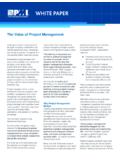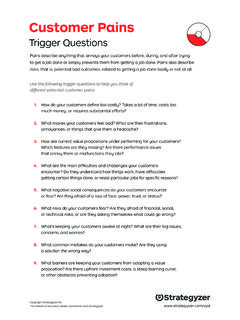Transcription of Customer- centricity Embedding it into your organisation’s …
1 Customer- centricityEmbedding it into your orga n isation s DNAL eading business advisers 2 ContentsForeword 3 Introduction 41. Visible, Customer- focused leadership 52. Understand your customer 63. Design the experience 74. Empower the frontline 95. Engage the back office 106. Metrics that matter 117. Feedback drives continuous improvement 128. Tangible actions 13 Conclusion 16 Contact us 17 3 ContentsForewordFew organisations have the necessary organisational culture to deliver truly Customer- centric customer experiences. Often, a well-intentioned strategy is diluted by operational constraints (whether real or perceived) and a loss of focus, resulting in little more than lip-service being paid to the concept of many organisations focus on trying to deliver world class service rather than giving customers what they actually want, which in most cases is a quick and easy process to follow, that is right first time.
2 There is a disconnect between strategy and vision, and the operational staff and the behaviours that are required to really deliver the customer experience. In our experience, this is usually caused by siloed business units, misaligned reward and recognition packages, and a lack of executive buy-in. Regulatory or other enforced processes are used as an excuse to provide poor customer experiences without considering other experience based principles that can be used to manage and improve the customer experience. Traditional customer feedback is often reviewed days and weeks following the actual event. Digital and online social platforms such as Twitter, Facebook and Blogs are enabling mass feedback to be captured in real-time, and distributed across the business to those responsible to action immediately. Often, non Customer- facing business units form the greatest obstacle in preventing a company from becoming truly Customer- centric.
3 Organisations often over-focus on the frontline service delivery teams, and do not focus on creating the required mindsets, behaviours and processes, within the back and head-office focus over the last number of years has been on cost reduction and consolidation. Now that the growth agenda is firmly back on the table the time has come to refocus and ensure that the customer takes centre stage once again. Our team has worked with clients across a range of customer issues in particular customer experience, customer insight and customer service transformation and we are happy to talk with you to explore the issues enclosed thought leadership piece was authored by my colleague, Scott Wheatley, a partner in our UK practice and Chair of the customer Service Leaders sincerely,Cormac HughesPartner,Strategy & OperationsDeloitte DublinCustomer expectations and behaviours have changed dramatically over the past decade.
4 Organisations are expected to meet customers needs and expectations at every interaction, in return for customer loyalty. The ability to deliver this depends on the extent to which Customer- centricity is embedded within every single person in your business. 4 IntroductionFor today s organisations, becoming more Customer- centric isn t just a feel-good mantra, it s a core business requirement. Whether the challenge is increased regulatory pressure, consolidation, cost pressures, rapidly shifting consumer trends or, more likely, all of the above a customer centric focus can play an instrumental role in staying a step ahead of the competition. It can help grow revenues, improve efficiency, and drive performance. If it is embedded in your organisation it can also lead to sustainable profitability. From our experience, we have distilled seven areas to consider when Embedding the customer at the heart of your organisation:Lead from the top with a customer focused approach.
5 Embedding the customer at the heart of your operations needs to start with the senior management using their leadership to drive the customer focus within their your customers. customer profile data allows organisations to gain deep insight into the varying needs of their different customer segments. Analysis of the mix of backgrounds, preferences and spending habits allows you to tailor product and service requirements for each the experience. It is crucial to understand what the customer s journey looks like across the product lifecycle. This alternative view of your business processes allows you to empower your people who are serving customers at each of the key touch points along the the frontline. Our clients understand that many decisions, whether they are queries or complaints from customers, require immediate consideration in order to be resolved promptly. Removing the need to escalate decision making and empowering the frontline to make decisions will serve to improve the spectator experience at the point issues the supporting operations.
6 It is not just frontline staff or the leadership team that need tobe customer focused, support functions such as Procurement, IT, HR and Finance own processes and relationships that directly impact the customer and it is important they adopt a Customer- centric approach in carrying out their the right behaviours. Motivated and empowered staff will go that extra mile to ensure that customers are satisfied, particularly during the key moments of truth in the customer customer feedback to drive real-time improvements. Twitter, Blogging and Facebook are now mainstream channels where everybody has something to say. Leading edge customer focused organisations have gone to great lengths to define a customer insight and feedback strategy that allows them to identify and prioritise customer feedback from social media channels within hours. This will allow feedback to be passed to managers at the start of each day to allow them to make operational changes in near Customer- focused leadershipUnderstanding your customerDesign the experienceMetrics that matterEngage the back officeFeedback drives continuous improvementsEmpower the frontlinePutting Customer- centricity at the core of your Strategies for Embedding Customer- centricity into your organisation 51.
7 Visible, Customer- focused leadershipAccountable Customer- focused clear leadership from the top that articulates what Customer- centricity means to your business, and what it looks like in practice, is critical to creating a Customer- centric organisation. Whilst it is common to have someone responsible for the customer experience, organisations that are truly focused on building their business around their customers are empowering top executives to own the customer journey, from initial contact through to final means that individuals need to be accountable for customer experience at key touch points within the customer lifecycle. A key challenge that many organisations face is how to change service accountability from product driven or silo based views of the customer , and move the customer service function towards common, experience based indicators. Enabling this change is fundamental to driving the right number of organisations such as Oracle, have developed Chief customer Officer (CCO) roles at senior levels to help facilitate and drive some of these changes.
8 The CCO role is typically responsible for providing a single vision across all methods of customer contact and is often responsible for influencing business units both in the front and back office with the purpose of promoting the customers agenda. It is common for these roles to report the Chief Executive Officer (CEO) and in many instances the CCO is a member of the and common purposeSuccessful customer Service Leaders throughout the organisation must also have the ability to build strong relationships with key areas of the business that impact the customer experience. Often this means playing the role of peacemaker and teacher, to educate other business functions, such as IT and HR, about the impact that changes in other business functions have on the customer . High-level governance and lower level, cross-function working groups and relationships are fundamental to driving positive customer experiences.
9 Often starting with new projects, success will come through Embedding these behaviours into ongoing daily activities. New ways of communicatingAs customers have changed the way they interact with organisations and moved towards digital channels (Facebook, Twitter, Blogs ) It is essential that customer service leaders are seen to have a voice and presence through these digital channels. The ability to communicate and engage via short and direct messages is a powerful tool that allow customers and employees to keep up to date without having to spend large amounts of time searching, reading documents or listening to Jobs regularly used You Tube to make special announcements to Apple staff and customers, proving far more successful and engaging than the traditional methods such as mass email, by creating a more personal organisations have built large social networks that allow employees to communicate and engage with each other via digital channels allowing real- time engagement and communication not possible in traditional channels.
10 An emerging trend we are seeing is CEOs and other senior executives taking the time to respond personally to customer complaints and feedback via these same digital edgeSome organisations are implementing customer rooms, a customer centric space where the customer experience is brought to life. Key experience touch points are highlighted around the walls of the room, including actual examples of the services the customer experiences. The idea is to draw out opportunities to create a better outcome for the customer by having a clear view of customer feedback and complaints insights along with the key but not leastSome of the more traditional and informal methods of communication are often over looked. Water-cooler conversations whereby senior executives relay real stories of employees delivering exceptional customer service, are a simple yet extremely effective way to show awareness from the top of what s happening and the frontline.

















